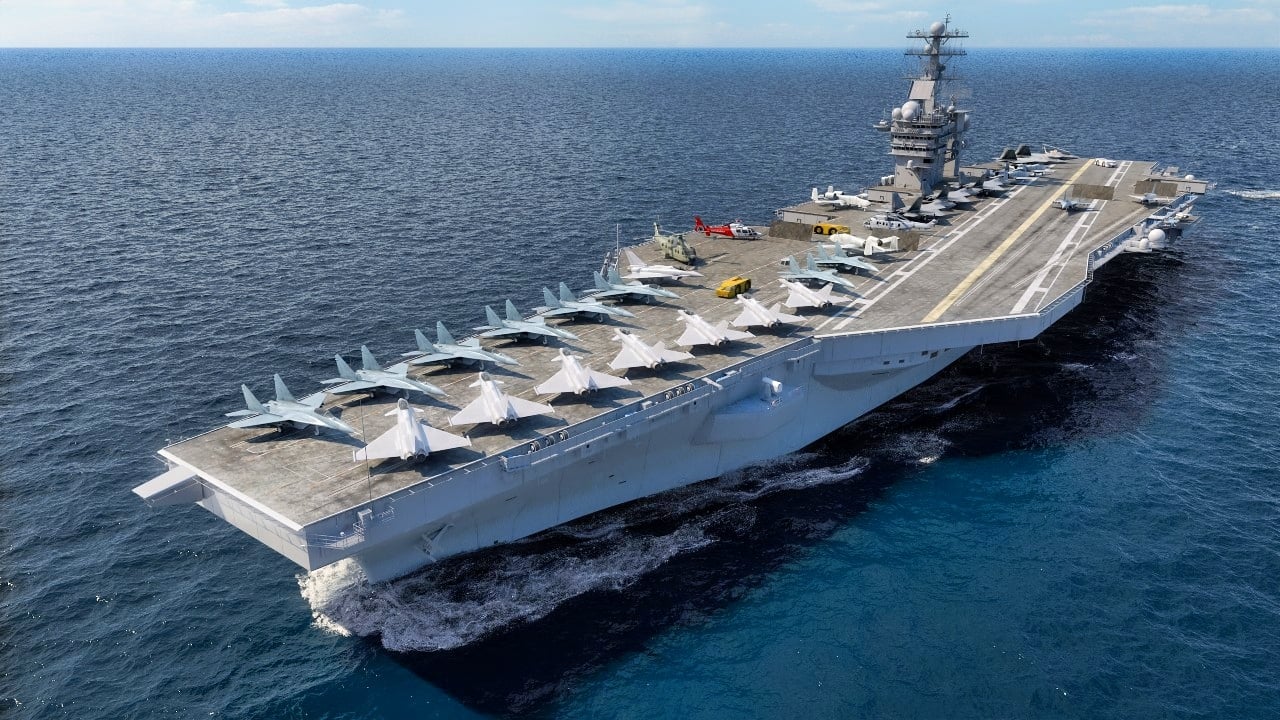Drones and Missiles Mean Navy Aircraft Carriers are in Deep Trouble
The U.S. Navy's aircraft carriers, long the dominant force in maritime strategy, face increasing threats from advanced weapons systems like hypersonic missiles, anti-access/area denial (A2/AD) capabilities, and drone swarms.
Summary: The U.S. Navy's aircraft carriers, long the dominant force in maritime strategy, face increasing threats from advanced weapons systems like hypersonic missiles, anti-access/area denial (A2/AD) capabilities, and drone swarms.
-Despite owning 11 of the world's most advanced carriers, the U.S. faces challenges from China's development of "carrier-killing" weapons, including the DF-21 missile which can target ships up to 1,000 miles offshore.
-Additionally, Russia and China's investments in hypersonic technology capable of Mach 5.0 speeds further complicate the security environment. While these developments pose significant risks, the U.S. Navy is adapting its strategies to maintain its superiority and effectively counter these emerging threats.
Emerging Threats to U.S. Aircraft Carriers in the Age of Hypersonic Missiles and A2/AD
The aircraft carrier is the crown jewel of the U.S. Navy. These massive floating airports have persevered as the centerpiece of modern combat fleets for decades, launching fighter jets, helicopters, and other critical aircraft wherever in the world they might be needed. But the carrier is vulnerable to new technologies. Hypersonic weapons, drone swarms, and anti-access/area denial (A2/AD) capabilities threaten to end the carrier’s reign over the oceans.
The capability to project military power through the mobile air forces aboard carriers has helped the U.S. retain maritime superiority. The U.S. Navy currently operates 11 aircraft carriers, and they are widely considered to be the most advanced flattops in the world. China possesses only three carriers. While it will take Beijing many years to catch up to Washington in terms of carrier numbers, the People’s Liberation Army (PLA) is prioritizing the development of carrier-killing weaponry.
What Weapons Could Target an Aircraft Carrier?
Designed to prevent U.S. intervention in regional conflicts, China’s DF-21 missile remains a crucial component of the PLA’s A2/AD capabilities. This weapon was introduced in the 1990s as a successor to the Dong Feng-2.
Beijing likely possesses more than 1,000 of these medium-range missiles today, according to a recently released Pentagon report. Since the devices can target maritime threats with precision and might be able to reach U.S. aircraft carriers 1,000 miles offshore, they pose a significant challenge to U.S. naval dominance in the Western Pacific.
The DF-21 uses a solid propellant and fires from a Transporter-Erector-Launcher vehicle, making the weapon portable and quick to launch. As the threat arena in war constantly changes, the DF-21’s ability to launch from various environments is an important asset.
Beijing has vowed to take control of Taiwan in the near future, and if China goes to war to conquer the island nation, the DF-21 and other A2/AD weapons could be used to prevent enemy warships from entering the East or South China Seas.
The Navy’s carrier-based fighters – the F/A-18 Super Hornet and F-35 Lightning II – have limited ranges, but a U.S. carrier would have to be positioned more than 1,000 miles offshore in order to avoid being put at risk by the DF-21. If one of these weapons were launched, it could also be deployed with maritime intelligence capabilities, over-the-horizon radars, and other threat amplifiers.
A 2020 Congressional Research Service report detailed the increasing threat these ballistic missiles present to U.S. interests in the South China Sea, warning that “China’s navy is viewed as posing a major challenge to the U.S. Navy’s ability to achieve and maintain wartime control of blue-water ocean areas in the Western Pacific – the first such challenge the U.S. Navy has faced since the end of the Cold War.”
In recent years, both China and Russia have developed initial versions of hypersonic weapons that are capable of traveling faster than Mach 5.0. These missiles are also designed to make unexpected changes in flight after they are launched, potentially putting U.S. carriers at risk. Russia’s Kinzhal ballistic missile has an estimated range of at least 300 miles and a reported maximum speed of Mach 10.
The Zircon missile also being developed in Russia is reportedly capable of striking both ground and naval targets. China’s own hypersonic missile arsenal includes the DF-17 medium-range ballistic missile, which is paired with a hypersonic glide vehicle that has a range of roughly 1,600 kilometers. The DF-14 intercontinental ballistic missile also carries a hypersonic glide vehicle. If a war breaks out in the South China Sea, the PLA could use hypersonic missiles to more than double its range, posing a severe threat to U.S. carriers.
There are also cheaper options that could take out a carrier. Swarm drones threaten all warships at sea, even the most advanced ones.

While it is highly improbable that a few dozen or even 100-plus lethal drones could evade a Nimitz-class or Ford-class carrier’s ample missile defense systems, new technologies might change the equation down the line.
Despite these potential threats, the U.S. carrier is still the greatest weapon the Navy possesses. The service is already shifting its strategy to be able to better contend with and prepare for the growing threat of anti-ship capabilities.
About the Author: Maya Carlin
Maya Carlin, National Security Writer with The National Interest, is an analyst with the Center for Security Policy and a former Anna Sobol Levy Fellow at IDC Herzliya in Israel. She has by-lines in many publications, including The National Interest, Jerusalem Post, and Times of Israel. You can follow her on Twitter: @MayaCarlin.


